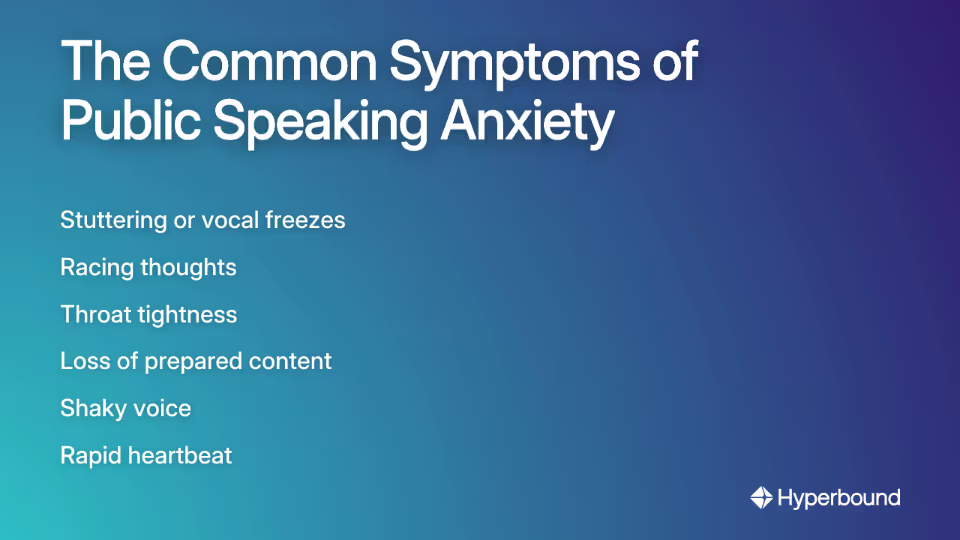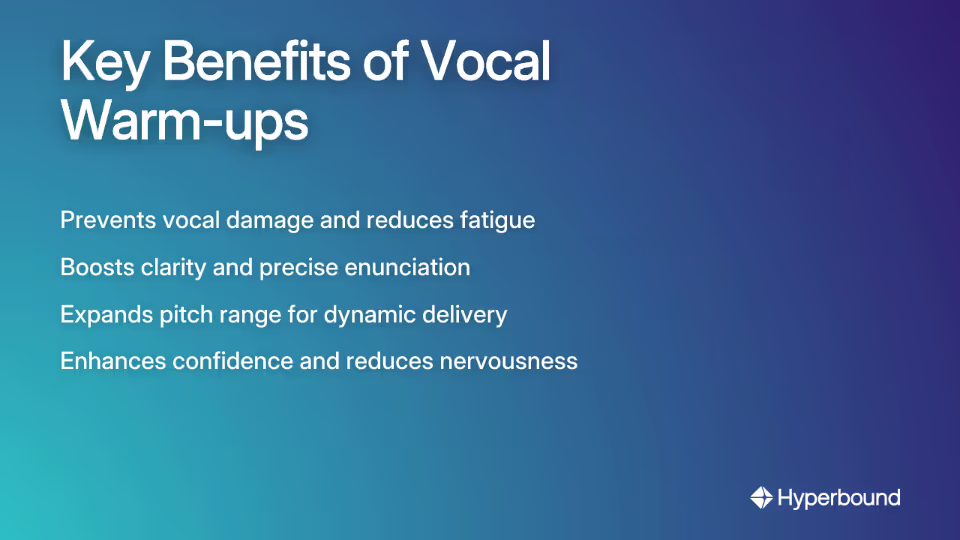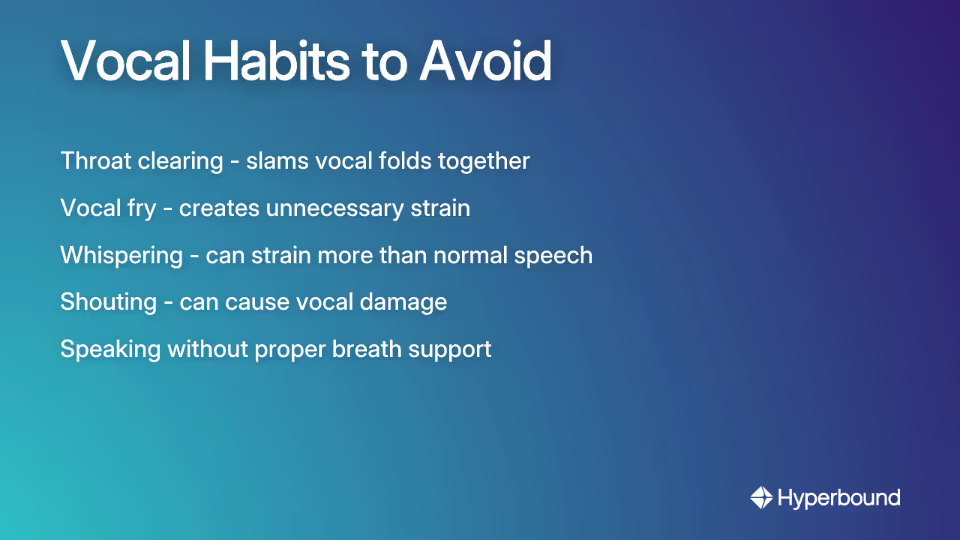.avif)
You're in a high-stakes stakeholder meeting, and all eyes are on you. You need to articulate an intricate technical idea, but when you open your mouth, you end up stuttering. Your mind races, your throat tightens, and suddenly that brilliant concept you were about to share is trapped behind a wall of anxiety.
Sound familiar? You're not alone.

Approximately 73% of the population suffers from public speaking anxiety or stage fright. This fear often manifests as a "brain freeze" or a voice that cracks under pressure, potentially undermining your professional credibility in crucial moments.
But there's a practical, physiological solution that goes beyond motivational platitudes: vocal warm-ups.
Just like any other muscle, your vocal muscles need to be warmed up to work at their best. A simple 5-minute warm-up routine can dramatically improve your vocal quality, enhance your confidence, and ensure your message is delivered with the clarity and impact it deserves.
In this article, we'll explore five essential speech voice exercises that target different aspects of your vocal instrument: breathing, relaxation, articulation, pitch, and integration. These practical drills will prepare you physically and mentally for your next speaking engagement, whether it's a team meeting, client presentation, or keynote speech.
The "Why": Understanding Your Vocal Instrument Before You Tune It
Before diving into the exercises, it's important to understand the mechanics behind your voice. When you speak, you make sounds in your larynx (voice box) with your vocal folds. These delicate tissues vibrate to create sound, which is then shaped by your tongue, lips, and jaw to form words.
Warming up stretches the vocal folds and increases blood flow to the larynx and other body parts including your lungs, lips, and tongue. This preparation offers several tangible benefits:

- Prevents Vocal Damage: Warming up reduces the risk of
vocal strainandvocal fatigue, particularly during longer speaking engagements. - Boosts Clarity: It prepares your articulators (tongue, lips, jaw) for precise
enunciation, ensuring your words are crisp and clear. - Expands Pitch Range: A warmed-up voice can reach a wider range of pitches, which is critical for making your speech dynamic and engaging rather than monotone.
- Enhances Confidence: The physical act of preparing reduces nervousness and makes you feel more in control, creating a positive feedback loop that improves your overall delivery.
Now that you understand why these exercises matter, let's dive into the specific drills that will transform your speaking voice.
Exercise 1: Breathing & Support (The Power Source)
Your breath is the engine of your voice. Diaphragmatic breathing provides a steady, powerful stream of air, preventing a weak or shaky voice and allowing you to speak through long sentences without losing strength.
The Book on the Belly
This classic exercise helps you develop awareness of proper diaphragmatic breathing:
- Lie comfortably on your back.
- Place a light book on your abdomen.
- Inhale deeply through your nose, focusing on making your belly rise and lift the book. Your chest should remain relatively still.
- Exhale slowly through your mouth, feeling your abdomen contract and the book lower.
- Repeat 5-10 times, focusing on a smooth, controlled motion.
4-4-4 Controlled Breathing
This exercise can be done standing or sitting and is perfect right before walking into a meeting:
- Sit or stand with a straight spine.
- Inhale slowly through your nose for a count of four.
- Hold your breath gently for a count of four.
- Exhale slowly and completely through your mouth for a count of four.
- Repeat, gradually increasing the count to six or eight as you feel more comfortable.
By mastering these breathing exercises, you're building the foundation for a strong, confident voice that won't falter mid-presentation.
Exercise 2: Loosening & Relaxation (Releasing Tension)
Tension in your jaw, lips, and throat can constrict your voice, leading to a strained sound and poor articulation. These exercises release that tension for a more open, resonant voice.
The Yawn-Sigh
This exercise simultaneously relaxes your throat and jaw:
- Inhale deeply as if you are beginning a natural, full yawn.
- Let your jaw drop open, wide and relaxed.
- As you exhale, produce a gentle, audible sigh, starting on a higher pitch and letting it fall naturally to a low, comfortable note.
- This simultaneously stretches the
jaw releasemuscles and relaxes the entire vocal tract. - Repeat 3-5 times, feeling the tension melting away with each sigh.
Lip Trills (The Motorboat)
Lip trills are a favorite among professional speakers and performers for good reason:
- Close your lips loosely and relax your jaw.
- Exhale a steady stream of air through your lips, causing them to vibrate and create a "brrrrrrr" sound, like a motorboat or a horse.
- Once you can hold a steady trill, add sound. Start on a comfortable note and glide your pitch up and down the scale while maintaining the trill.
- Focus on the buzzing sensation in your lips and face. This relaxes the lips and warms the
vocal foldswith gentle pressure.
If you're struggling to get the lip trill working, try placing a finger at each corner of your mouth to help support your lips until you develop the muscle memory.
Exercise 3: Articulation & Clarity (Sharpening Your Words)
Mumbling or stumbling over words undermines your credibility. Articulation drills act like precision training for your tongue and lips, ensuring every word is crisp, clear, and easily understood.
Tongue Twisters
Tongue twisters are more than just fun challenges—they're serious training tools for speech clarity:
- Choose a classic tongue twister. Examples:
- "Peter Piper picked a peck of pickled peppers"
- "She sells seashells by the seashore"
- "Red leather, yellow leather"
- Start by saying it slowly, exaggerating the movement of your lips and tongue for each sound.
- Gradually increase your speed, but only as fast as you can maintain perfect clarity. The goal is precision, not speed.
- Repeat 3-5 times, focusing on different parts of your mouth and tongue with each repetition.
Articulator Pronunciation
This exercise targets the specific muscles used in clear speech:
- Focus on clean, explosive consonant sounds.
- Repeat the sounds "Ma, Ma, Ma, Ma" with clear, sharp
enunciation. - Then, repeat "Pa, Pa, Pa, Pa" feeling the popping sensation of your lips.
- Finally, repeat "Ta, Ta, Ta, Ta" noticing how your tongue touches behind your upper teeth.
- For each set, gradually increase your speed while maintaining clarity.
By training these specific articulators, you're developing the muscle memory needed for clear speech even under pressure.

Exercise 4: Pitch & Resonance (Adding Color to Your Voice)
A monotone voice puts audiences to sleep. Resonance gives your voice a rich, full quality, while pitch variation adds emotion and interest, keeping your listeners engaged.
Humming & Chanting
These exercises activate the resonating chambers in your face and chest:
- Humming: Close your lips and make a gentle "hmmmm" sound. Feel the vibrations in your chest, throat, and the front of your face (your "mask"). Glide the hum up and down in pitch.
- Chanting: To enhance
resonance, chant the following sounds, holding each one for a few seconds:- "Meem..."
- "Mime..."
- "Mohm..."
- "Moom..."
Gentle Sirens
This exercise expands your pitch range and vocal flexibility:
- On a soft "ooo" or "eee" vowel sound, smoothly glide your voice from your lowest comfortable pitch to your highest comfortable pitch, like an ambulance siren.
- Then, smoothly glide back down.
- The goal is a smooth transition with no breaks or cracks.
- Repeat 3-5 times, focusing on maintaining an even, connected sound throughout your range.
This exercise increases your vocal flexibility and control over your pitch range, allowing you to add emphasis and emotion to key points in your presentation.
Exercise 5: Integration & Practice (Putting It All Together)
Once the individual components are warm, it's time to integrate them into speech-like patterns. This bridges the gap between isolated drills and real-world speaking.
The "Say Anything" Game
This simple yet effective exercise activates your expressive abilities:
- Pick a simple, neutral word, like "Hello" or "Okay."
- Say the word in as many different ways as you can:
- Say it as a question
- Say it with excitement
- Say it with boredom
- Say it with authority
- Say it with skepticism
- Say it as if you're confiding a secret
- This simple game activates your control over pitch, tone, and emotional expression in a low-stakes way.
Reading Aloud with Over-Enunciation
This exercise builds muscle memory for clear speech:
- Take any piece of text (an email, a news article, or ideally, notes from your upcoming presentation).
- Read it aloud, but exaggerate every single mouth movement.
- Make your consonants extra crisp and your vowels extra open.
- Speak slowly, focusing on feeling the movement of your lips, tongue, and jaw for every syllable.
After practicing with exaggeration, read the text again at a normal pace. You'll notice your articulation remains clearer than before, even without the exaggeration.
Bonus: Techniques for Peak Performance & Vocal Health
For Calming Nerves:
The 3-Second Fix (Nostril Breathing): This technique helps center you in moments of acute anxiety:
- Cover your right nostril with your thumb.
- Breathe in deeply through the left nostril.
- Hold for a moment.
- Cover your left nostril with your ring finger (releasing the right) and exhale through the right nostril.
- Repeat 3-4 times.
Reframe Your Fear: Nervousness and excitement are physiologically similar. Instead of telling yourself "I'm nervous," try telling yourself "I'm excited." Research from Harvard Business Review shows that this simple cognitive shift can transform your performance anxiety into positive energy.
The Post-Speech Cool Down:
Your voice needs to recover after a long speech or presentation, just as your body needs to cool down after exercise:
Gentle Humming: Hum the sound 'm' on a low, comfortable pitch, focusing on the vibration for a couple of minutes. This gently massages the vocal folds and helps them return to a resting state.
Hydration: Drink room temperature water to rehydrate your vocal apparatus. Avoid ice cold beverages which can constrict your vocal folds.
A Critical Note on Vocal Health:
If your voice hurts just from using it for a short time, you should stop. Gentle warm-ups should feel good and relaxing. Pain is a signal to rest.
Avoid these common vocal habits that can damage your voice:

- Throat clearing: This slams your vocal folds together harshly. Instead, try swallowing or taking a sip of water.
- Vocal fry: That low, creaky sound (think Kardashian-style speaking) can be hard on your vocal folds when overused.
- Whispering: Contrary to popular belief, whispering can strain your voice more than normal speech.
If you experience persistent pain, hoarseness, or other vocal issues, it is essential to consult a doctor or a speech-language pathologist.
From Warm-Up to Wow: Conclusion
These five types of speech voice exercises—Breathing, Relaxation, Articulation, Pitch, and Integration—provide a simple yet powerful toolkit for any speaker. By understanding your vocal instrument and preparing it properly, you can significantly improve how you communicate in any professional setting.
The magic isn't in doing these exercises once, but in making them a habit. Incorporate them into your daily routine—while you shower, during your commute, or for five minutes before your first video call. Studies show that voice quality significantly influences how listeners perceive a speaker's personality and credibility, making this preparation crucial.
Remember, a strong, confident, and clear voice is not a gift, but a skill. By investing a few minutes in preparation, you are ensuring your ideas are heard and your presence is felt.
Ready to Take Action?
Before your very next meeting, try just one of these exercises. We recommend starting with the Lip Trills as they provide immediate feedback and quickly warm up the voice.
If you're looking for a way to practice these skills and get personalized feedback, platforms like Hyperbound offer AI-powered roleplays and real call analysis. This allows you to practice in a safe environment and receive objective, data-driven insights on your articulation, pitch, and overall delivery, helping you identify unique vocal patterns and optimize your speaking style at scale.
Your voice is your most powerful tool for communication—treat it with care, prepare it with intention, and watch as your speaking impact transforms from adequate to exceptional.
Frequently Asked Questions
Why are vocal warm-ups important for public speaking?
Vocal warm-ups are crucial because they prepare your vocal muscles for speaking, which helps prevent strain, improves clarity, and boosts confidence. Just as an athlete warms up before a game, warming up your voice increases blood flow to the larynx and stretches the vocal folds. This preparation results in a clearer, stronger voice and reduces the risk of it cracking or sounding shaky under pressure.
How long should you warm up your voice before speaking?
A 5-minute warm-up is highly effective for most situations, while 10-15 minutes is ideal for a major presentation or keynote speech. The goal is quality over quantity. Even a few minutes of focused exercises like lip trills and diaphragmatic breathing can significantly reduce anxiety and improve vocal quality.
What is the best vocal exercise to do if you are short on time?
The single best exercise for a quick warm-up is the lip trill (the "motorboat" sound). It is incredibly efficient because it relaxes the lips and jaw, engages breath support, and gently warms the vocal folds all at once. You can do this for just 60 seconds while gliding your pitch up and down to quickly prepare your voice.
How can I overcome feeling self-conscious while doing voice exercises?
You can overcome feeling self-conscious by doing the exercises in a private space, like your car, a restroom, or an empty office before a meeting. It also helps to remember that top performers—from actors to executives—use these techniques as part of their professional preparation. Practicing with an AI tool like Hyperbound's AI Sales Roleplays can also be a great way to build confidence without the pressure of a live audience. Starting with silent exercises, like controlled breathing, can also help you get comfortable.
Can voice exercises help reduce a shaky voice from nervousness?
Yes, voice exercises are very effective at reducing a shaky voice. A shaky voice is often caused by shallow, uncontrolled breathing due to anxiety. Breathing exercises, especially diaphragmatic breathing, regulate your nervous system and provide a steady stream of air to support your voice. This physical control helps counteract the "fight or flight" response, leading to a more stable, confident sound.
Should I do these exercises every day or just before speaking?
For the best results, a combination of both is ideal. Daily practice, even for a few minutes, builds long-term vocal strength and flexibility. A dedicated warm-up right before you speak prepares your voice for the immediate task. Think of it like athletic training: you train regularly to build capacity and also warm up right before a game for peak performance.
Book a demo with Hyperbound
.png)













